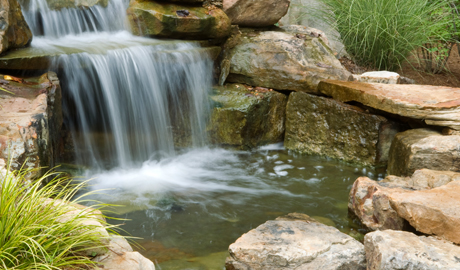Guide to Over-Wintering Your Pond

Over-Wintering Your Pond
Checking Despite all outward appearances the pond is active even when the water is cold or even frozen. Dead leaves, algae, insects and solid fish waste that have accumulated over the summer slowly break down during the winter months. This natural decomposition uses oxygen and produces hydrogen sulfide, a toxic gas. A build up of leaves, uneaten fish food and fish wastes can produce excessive hydrogen sulfide and at the same time, reduce oxygen to dangerously low levels. This can cause all of your plants and fish to die. Pond netting used to catch leaves and along with the following fish information can help to prevent this.
First, remove all debris you can with a coarse net, which you should have been doing throughout the year (to prevent more leaves, drape a pond net over it). Next, use a fine net to remove any sludge covering the bottom. Since you’re in there stirring things up a bit, you should change about 50% of the water, too. If your pond has a lot of “junk” at the bottom of it and is tinted yellow from dissolved organic material, make (2) 30-50% water changes a day or two apart. When you’re pumping out the water, stir up the sludge and clean the bog and/or marginal shelves, etc. After everything is cleaned, start to fill with tap water. Add to your tap water some type of water de-chlorinator.
Lock and Load
If you’re really concerned about the chlorinated water, add some Ammo Lock to instantly neutralize the chlorine and chloramines in the tap water so it doesn’t harm the fish (It also locks ammonia so if you ever have high ammonia levels in your pond, you can use the Ammo Lock). It is imperative that you get rid of the chlorine in the tap water or else it will kill your fish. Plants don’t like the chlorine either. Add Pondzyme to your pond, to get “good” bacteria working in your filter, etc.
The metabolism of koi and goldfish is controlled primarily by water temperature. As the water cools, their metabolism slows down and they require less food and food with less protein. When fed high-protein diets in cool water, the excess protein is excreted as ammonia, and the fish can get sick and die from the high levels of ammonia. Eliminate the high protein diets when the water temperature goes below 60°F and start feeding them “Spring and Autumn Fish Food”. This type of fish food is better for the dietary requirements for the fish and won’t pollute the water with excess ammonia. Feed them about 20% of what you would in the summer and you should be fine. Stop feeding your fish when the temperature of the pond goes below 50°F. If the fish don’t eat the food, of course, stop feeding them or else the uneaten food will only settle to the bottom and add to the overall nutrients in the water.
A Dash of Salt
For those of you who have ponds with fish and no plants, your fish can benefit from the addition of Pond salt. Pond salt provides electrolytes to the fish and gives them a nice, soothing protective coating. It acts as a barrier from bacteria, fungus, and parasites that attack the fish. Use a .3 – .5% salt solution if you don’t have any plants and only have fish, and about a 2% salt solution if you have both plants and fish. Salt is ideal to use in the fall and spring when the fish’s immune system is compromised and some bad types of bacterial strains and parasites are still active and growing. Also, some beneficial bacteria may die with a higher salt solution, so be careful on the amount you choose.
Your pond may not be crystal clear, but your fish can be healthier because of it. If in doubt, just check the ammonia levels in the pond. A 2-3% salt solution is a pretty safe bet. There are specific test kits that test for salt levels. They are referred to as salinity monitors. You can find them in our stores.
